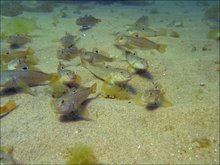updated 1-11-2009
Most of the articles on the opening of the lower Fox River locks excitedly boast of the economic boom that the openings will bring to the region, allowing pleasure boaters the freedom to pass from Lake Michigan to Lake Winnebago by 2010. However, few articles mention the very negative impacts that the opening of the locks will also have.
The unequal number of commentaries by proponents of opening of the locks may be because the employees of the Wisconsin Department of Natural Resources – the experts on the matter – are not allowed to voice their opinions without jeopardizing their jobs. It is their job to uphold the position of the DNR (to promote passage), while the best way to protect the Lake Winnebago waters to keep the locks closed (to maintain the health of the ecosystem).
Why is DNR position counterintuitive? It is one of those 'political' problems. The DNR was assigned a formal seat on the Fox River Locks Navigational Authority – whose mission is to promote the passage of boats on the lower Fox River. The Navigational Authority gave DNR employees the task of finding techniques to control and monitor for aquatic invasive species (AIS). Therefore, DNR personnel have no capacity to recommend that the locks remain closed.
The Lake Winnebago system is the largest watershed (the Fox-Wolf Watershed) to feed into Lake Michigan, and the third largest to feed into the Great Lakes. This water system is unique because not only does it have few consumption advisories, but also because it is the only major water body that remains relatively free of invasive species compared to the rest of the Great Lakes and its watersheds. Lake Winnebago has only 6 major aquatic invasive species, while the Great Lakes have over 180.
If new exotic species become established in the Lake Winnebago system, they are likely to have major impacts on the native game and forage fish species. Some of the immediate species of concern include:
· White perch and Eurasian ruffe have voracious appetites for eggs and young fish and may out compete, and therefore reduce, game fish populations including walleye, largemouth and smallmouth bass, and sunfish populations.
· Round gobies are extremely adaptable, and will devour any eggs on the lake bottom. Where they are established, with live bait it is difficult to catch anything but gobies.
· Lake Winnebago has many suitable spawning streams for sea lamprey, which is a parasite that prefers fish species without scales. According to past evidence from other Great Lakes, this parasite would cause populations of fish such as the Sturgeon, Walleye, and Northern Pike to significantly decline in the Lake Winnebago system.
· The spiny and fish hook water fleas replace large quantities of zooplankton that fish fry need for food. They themselves are not very edible due to their long spines, which will perforate the guts of fish.
· Having been discovered in 1998, zebra mussels are already established in Lake Winnebago, but quagga mussels are replacing zebra mussel populations throughout the Great Lakes. Quagga mussels can survive in a wider variety of habitats than zebra mussels, and therefore will increase the total number of mussels. The filtering power of these exotic mussels wipes out the primary level in the food chain. They reduce algae that other small invertebrates feed upon - thereby reducing the number of invertebrates, which are a significant component of most fish diet.
· Although the likelihood of establishment is uncertain, rainbow smelt feed aggressively on fry of other fish species.
· The newest major invader to the Great Lakes is a very serious disease of fishes called Viral Hemorrhagic Septicemia (VHS). In Europe, it is considered the most serious disease of salmon and trout, and it infects more than 40 other fish species. It causes massive fish kills mostly in spring when the water temperatures are suitable for it. There are many new federal regulations restricting the transport of fish because of this disease.
· The list goes on and on.
DNR biologists have predicted that the recreational fishery of Lake Winnebago will irreversibly change – or even vanish – within a few years of opening the locks. However, all they can do is to devise methods to slow down the arrival of AIS. Because the control methods proposed so far appear to be mostly feeble and/or impractical, their job will become monitoring the arrival of new species. Monitoring does little good as a control method when we do not have the technology to eradicate them once they've arrived. If we had that technology, wouldn't we have done that in the places they've invaded already? Eventually DNR biologists expect to document the decimation of Lake Winnebago’s ecosystem, which includes the decline of its valuable sport fishery.
The anglers have a new saying: “These are the good old days of fishing.”
A recent economic analysis done by UW-Extension estimated that Lake Winnebago’s sport fisheries bring $234 million annually to this region. The opening of the lower Fox River was originally estimated to be ~$70 million, but promoters of the opening say that figure needs to be updated. It is heartbreaking that the possibility of economic growth is being weighed against the importance ecological stability.
The uniquely preserved ecosystem of the Winnebago system will simply not be maintained by reducing the ~39 miles of barriers down to ~5 feet with the one barrier that is to remain at Wrightstown.
Is it too late to make a stand against opening the locks? A lot of money has already been invested into the lock’s restoration, and the proponents have been stealthy in their approach. DNR hands are tied, and the opening of the locks has been portrayed as an altogether positive and anticipated event.
Thursday, April 19, 2007
Subscribe to:
Comments (Atom)









